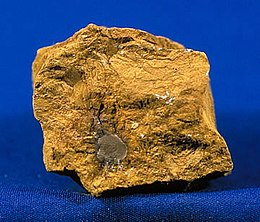| Limonite | |
|---|---|
 | |
| General | |
| Category | Amorphous, mineraloid |
| Formula (repeating unit) | FeO(OH)·nH2O |
| Strunz classification | Unclassified |
| Identification | |
| Color | Various shades of brown and yellow |
| Crystal habit | Fine grained aggregate, powdery coating |
| Cleavage | Absent |
| Fracture | Uneven |
| Mohs scale hardness | 4–5.5 |
| Luster | Earthy |
| Streak | Yellowish brown |
| Diaphaneity | Opaque |
| Specific gravity | 2.9–4.3 |
| Density | 2.7–4.3 g/cm3 |
| References | [1][2][3] |
Limonite (/ˈlaɪməˌnaɪt/) is an iron ore consisting of a mixture of hydrated iron(III) oxide-hydroxides in varying composition. The generic formula is frequently written as FeO(OH)·nH2O, although this is not entirely accurate as the ratio of oxide to hydroxide can vary quite widely. Limonite is one of the three principal iron ores, the others being hematite and magnetite, and has been mined for the production of iron since at least 400 BC.[4][5]
- ^ Limonite, Mindat.org, retrieved 2011-10-16
- ^ "Mineral 1.0: Limonite". Retrieved 2011-10-16.
- ^ "Limonite (hydrated iron oxide)". Retrieved 2011-10-16.
- ^ MacEachern, Scott (1996) "Iron Age beginnings north of the Mandara Mountains, Cameroon and Nigeria" pp. 489–496 In Pwiti, Gilbert and Soper, Robert (editors) (1996) Aspects of African Archaeology: Proceedings of the Tenth Pan-African Congress University of Zimbabwe Press, Harare, Zimbabwe, ISBN 978-0-908307-55-5; archived here by Internet Archive on 11 March 2012
- ^ Diop-Maes, Louise Marie (1996) "La question de l'Âge du fer en Afrique" ("The question of the Iron Age in Africa") Ankh 4/5: pp. 278–303, in French; archived here by Internet Archive on 25 January 2008